Top 27 Artificial Neural Network Software
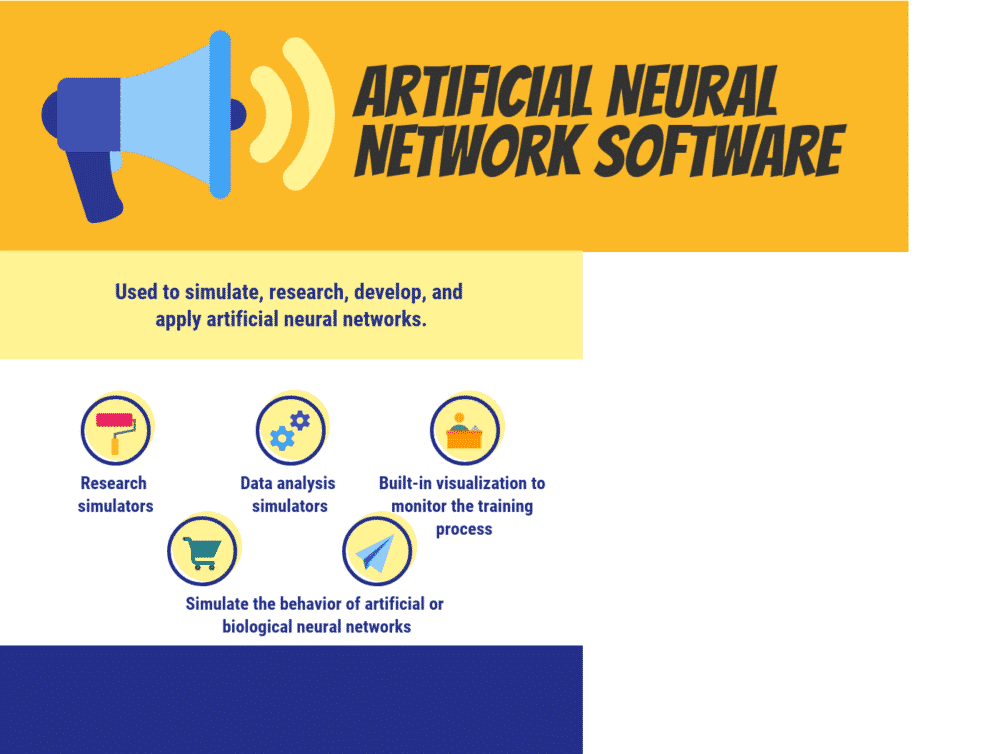
Artificial Neural network software apply concepts adapted from biological neural networks, artificial intelligence and machine learning and is used to simulate, research, develop Artificial Neural network. Neural network simulators are software applications that are used to simulate the behavior of artificial or biological neural networks which focus on one or a limited number of specific types of neural networks.
They are typically stand-alone and not intended to produce general neural networks that can be integrated in other software. Simulators usually have some form of built-in visualization to monitor the training process and some simulators also visualize the physical structure of the neural network. In order for neural network models to be shared by different applications, Predictive Model Markup Language (PMML) is used. PMML is an XML-based language which provides a way for applications to define and share neural network models and other data mining models between PMML compliant application.
Top Artificial Neural Network Software: Neural Designer, Neuroph, Darknet, Keras, NeuroSolutions, Tflearn, ConvNetJS, Torch, NVIDIA DIGITS, Stuttgart Neural Network Simulator, DeepPy, MLPNeuralNet, DNNGraph, AForge.Neuro, NeuralN, NeuralTalk2, Knet, cuda-convnet2, DN2A, Mocha, HNN, Lasagne, neon, LambdaNet, gobrain, RustNN, deeplearn-rs are some of the Top Artificial Neural Network Software.
What are Artificial Neural Network Software?
Artificial Neural Network Software is used to simulate, research, develop, and apply artificial neural networks, software concepts adapted from biological neural networks.
Artificial Neural Network Software are intended for practical applications of artificial neural networks with the primary focus is on data mining and forecasting. These data analysis simulators usually have some form of preprocessing capabilities and use a relatively simple static neural network that can be configured.
Top Artificial Neural Network Software
Neural Designer
Neural Designer is a desktop application for data mining which uses neural networks, a main paradigm of machine learning. The software is developed by the startup company called Artelnics, based in Spain and founded by Roberto Lopez and Ismael Santana. Neural networks are mathematical models of the brain function, computational models which are inspired by central nervous systems, in particular the brain, which can be trained to perform certain tasks. Neural networks are capable of machine learning as well as pattern recognition. Neural networks are generally presented as systems of interconnected neurons, which can compute outputs from inputs. Neural network…
High performance computing
Easy to use
Visualization
Advanced Analytics
Neuroph
Neuroph is lightweight Java neural network framework to develop common neural network architectures. It contains well designed, open source Java library with small number of basic classes which correspond to basic NN concepts. Also has nice GUI neural network editor to quickly create Java neural network components. It has been released as open source under the Apache 2.0 license. Neuroph simplifies the development of neural networks by providing Java neural network library and GUI tool that supports creating, training and saving neural networks. Neuroph is best for beginners with neural networks, especially if the user just wanted to try how…
•Easy-to-follow Structure
•OCR Support
•Data Normalization
•Image Recognition Support
•Stock Market Prediction Sample
Contact for Pricing
•Easy-to-follow Structure
•OCR Support
•Data Normalization
Darknet
Darknet is an open source neural network framework written in C and CUDA. It is fast, easy to install, and supports CPU and GPU computation. Users can find the source on GitHub. Darknet is installed with only two optional dependencies: OpenCV if users want a wider variety of supported image types or CUDA if they want GPU computation. Neither is compulsory but users can start by just installing the base system which has only been tested on Linux and Mac computers. The framework features You Only Look Once (YOLO), a state-of-the-art, real-time object detection system. On a Titan X it…
•YOLO: Real-Time Object Detection
•ImageNet Classification
•Nightmare
•RNNs in Darknet
•DarkGo
•Tiny Darknet
•Train a Classifier on CIFAR-10
•YOLO: Real-Time Object Detection
•ImageNet Classification
•Nightmare
Keras
Keras is a deep learning library for Theano and TensorFlow. It is a high-level neural networks library, written in Python and capable of running on top of either TensorFlow or Theano. It was developed with a focus on enabling fast experimentation. Being able to go from idea to result with the least possible delay is key to doing good research. Keras deep learning library allows for easy and fast prototyping (through total modularity, minimalism, and extensibility). It supports both convolutional networks and recurrent networks, as well as combinations of the two. Keras also supports arbitrary connectivity schemes (including multi-input and…
•Modularity
•Minimalism
•Easy extensibility
NeuroSolutions
NeuroSolutions is an easy-to-use neural network software package for Windows. It combines a modular, icon-based network design interface with an implementation of advanced artificial intelligence and learning algorithms using intuitive wizards or an easy-to-use Excel interface. NeuroSolutions is designed to make neural networks easy and accessible to both novice and advanced developers. There are three basic phases in neural network analysis: training the network on the data, testing the network for accuracy and making predictions/classifying from new data. The Express Builder in the NeuroSolutions Excel interface can accomplish all of this automatically in one simple step. With NeuroSolutions Excel interface,…
•Cluster Analysis
•Sales Forecasting
•Sports Predictions
•Medical Classification
•NeuroSolutions Pro Single-user license: $1,495
•NeuroSolutions Single-user license: $495
•NeuroSolutions Student* Single-user license: $295
•Cluster Analysis
•Sales Forecasting
•Sports Predictions
Tflearn
TFlearn is a modular and transparent deep learning library built on top of Tensorflow. It was designed to provide a higher-level API to TensorFlow in order to facilitate and speed-up experimentations, while remaining fully transparent and compatible with it. The high-level API currently supports most of recent deep learning models, such as Convolutions, LSTM, BiRNN, BatchNorm, PReLU, Residual networks, Generative networks. In the future, TFLearn is also intended to stay up-to-date with latest deep learning techniques and it is currently in its early development stage. TFLearn requires Tensorflow (version >= 0.9.0) to be installed. The easiest way to install TFLearn…
•Easy-to-use and understand high-level API for implementing deep neural networks, with tutorial and examples.
•Fast prototyping through highly modular built-in neural network layers, regularizers, optimizers, metrics...
•Full transparency over Tensorflow. All functions are built over tensors and can be used independently of TFLearn.
•Powerful helper functions to train any TensorFlow graph, with support of multiple inputs, outputs and optimizers.
•Easy and beautiful graph visualization, with details about weights, gradients, activations and more...
•Effortless device placement for using multiple CPU/GPU.
•Easy-to-use and understand high-level API for implementing deep neural networks, with tutorial and examples.
•Fast prototyping through highly modular built-in neural network layers, regularizers, optimizers, metrics...
•Full transparency over Tensorflow. All functions are built over tensors and can be used independently of TFLearn.
ConvNetJS
ConvNetJS is a Javascript library for training Deep Learning models (Neural Networks) entirely in users’ browsers. Users just open a tab and they are training. No software requirements, no compilers, no installations, no GPUs, no sweat. The library allows users to formulate and solve Neural Networks in Javascript, and was originally written by @karpathy (a PhD student at Stanford). However, the library has since been extended by contributions from the community. The code is available on Github under MIT license. Pull requests for new features / layers / demos and miscellaneous improvements are encouraged. The library is also available on…
•Common Neural Network modules (fully connected layers, non-linearities)
•Classification (SVM/Softmax) and Regression (L2) cost functions
•Ability to specify and train Convolutional Networks that process images
•An experimental Reinforcement Learning module, based on Deep Q Learning.
•Common Neural Network modules (fully connected layers, non-linearities)
•Classification (SVM/Softmax) and Regression (L2) cost functions
•Ability to specify and train Convolutional Networks that process images
Torch
Torch is a scientific computing framework with wide support for machine learning algorithms that puts GPUs first. It offers an easy to use and efficient program to its users, thanks to an easy and fast scripting language, LuaJIT, and an underlying C/CUDA implementation. Users of Torch will be able to take advantage of its core features such as a powerful N-dimensional array, lots of routines for indexing, slicing, transposing, amazing interface to C, via LuaJIT, linear algebra routines, neural network, and energy-based models, numeric optimization routines, fast and efficient GPU support and embeddable, with ports to iOS, Android and FPGA…
•Powerful N-dimensional array
•Neural Network & Energy-based Models
•Fast and efficient GPU support
•Linear Algebra Routines
Torch is an Open Source program
•Powerful N-dimensional array
•Neural Network & Energy-based Models
•Fast and efficient GPU support
NVIDIA DIGITS
The NVIDIA DIGITS puts the power of deep learning into the hands of engineers and data scientists. DIGITS can be used to rapidly train the highly accurate deep neural network (DNNs) for image classification, segmentation and object detection tasks without the need to write code. NVIDIA DIGITS simplifies common deep learning tasks for its users such as managing data, designing and training neural networks on multi-GPU systems, monitoring performance in real time with advanced visualizations and selecting the best performing model from the results browser for deployment. NVIDIA DIGITS is completely interactive so that data scientists can focus on designing…
•Monitor Performance Real Time
•Advanced Visualizations
•Open Source Project
•Amazon Machine Image
Free
•Monitor Performance Real Time
•Advanced Visualizations
•Open Source Project
Stuttgart Neural Network Simulator
The Stuttgart Neural Network Simulator (SNNS) is a library containing many standard implementations of neural networks. This package wraps the SNNS functionality to make it available from within R. Using the 'RSNNS' low-level interface, all of the algorithmic functionality and flexibility of SNNS can be accessed. Furthermore, the package contains a convenient high-level interface, so that the most common neural network topologies and learning algorithms integrate seamlessly into R. The package provides a convenient interface to the popular Stuttgart Neural Network Simulator SNNS. It includes functions for visualization and analysis of the models and the training procedures, as well as…
•Encapsulation of the relevant SNNS parts in a C++ class, for sequential and parallel usage of different networks
•Accessibility of all of the SNNS algorithmic functionality from R using a low-level interface
•A high-level interface for convenient, R-style usage of many standard neural network procedures
•Encapsulation of the relevant SNNS parts in a C++ class, for sequential and parallel usage of different networks
•Accessibility of all of the SNNS algorithmic functionality from R using a low-level interface
Stuttgart Neural Network Simulator
DeepPy
DeepPy is a MIT licensed deep learning framework. DeepPy tries to add a touch of Zen to deep learning as it allows for Pythonic programming based on NumPy’s ndarray. It also has a small and easily extensible codebase while DeepPy runs on CPU or Nvidia GPUs. DeepPy Implements the following network architectures: Feedforward networks, Convents, Siamese networks and Autoencoders. However, note that DeepPy is by no means a mature project and should be considered WIP.
•Pythonic Programming
•Feedforward Networks
•Siamese Networks
•AutoEncoders
Contact for Pricing
•Pythonic Programming
•Feedforward Networks
•Siamese Networks
MLPNeuralNet
MLPNeuralNet is a fast multilayer perceptron neural network library for iOS and Mac OS X. MLPNeuralNet predicts new examples through trained neural networks. It is built on top of Apple's Accelerate Framework using vectored operations and hardware acceleration (if available). MLPNeuralNet is for users who have engineered a prediction model using Matlab (Python or R) and would like to use it in an iOS application. In that case, MLPNeuralNet is exactly what is needed. MLPNeuralNet is designed to load and run models in forward propagation mode only. Some of the features that users will be able to take advantage of…
•Works with iOS and Mac OS X
•Vectorised Implementation
•Works with double precision
MLPNeuralNet is an Open Source program
•Works with iOS and Mac OS X
•Vectorised Implementation
•Works with double precision
DNNGraph
DNNGraph is a deep neural network model generation DSL in Haskell. It is a DSL for specifying the model. This uses the lens library for elegant, composable constructions, and the fgl graph library for specifying the network layout. A set of optimization passes that run over the graph representation to improve the performance of the model. For example, users can take advantage of the fact that several layers types (ReLU, Dropout) can operate in-place. DNNGraph also offers a set of backends to generate code for the platform. Currently, DNNGraph generate Caffe (by generating model prototxt files) and Torch (by generating…
•Open source software
•Contribute Skills
•Track Contributions
•Visualization of Network Structure
Contact for Pricing
•Open source software
•Contribute Skills
•Track Contributions
AForge.Neuro
AForge.NET framework provides neural networks library, which contains set of classes aimed for creating different type of artificial neural networks and training them to solve certain tasks, like recognition, approximation, prediction, etc. The library mainly allows users to create two categories of artificial neural networks: feed forward neural networks with activation function and one layer distance networks. Feed forward neural networks are represented as one layer or as multi-layer networks which don't have recurrent connections. Information flows in these networks from inputs to outputs passing all layers of neural network only one time without doing loops. Neurons of such networks…
•Calculating XOR functions
•Multilayer Feed Forward Neural Networks
•Kohonen Self Organizing Map
•Calculating XOR functions
•Multilayer Feed Forward Neural Networks
•Kohonen Self Organizing Map
NeuralN
NeuralN is a C++ Neural Network library for Node.js with multiple advantages compared to existing solutions. It works with extra-large datasets (>1Go allowed by nodejs) and Multi-Threaded training available. With Node.js and the V8, it is not possible to work with large datasets since the maximum allowed memory is around 512MB for 32-bits machines and 1GB for 64-bits machines. When working with datasets of several gigabytes, it quickly becomes difficult to train the network with all the data. NeuralN allows users to use datasets as big as their memory can contain. Working with large datasets increases the performances of the…
•Large datasets
•Multi-Threaded
•Large datasets
•Multi-Threaded
NeuralTalk2
NeuralTalk2 is an efficient image captioning code in Torch that runs on GPU. Compared to the original NeuralTalk this implementation is batched, uses Torch, runs on a GPU, and supports CNN fine-tuning. All of these put together results in quite a large increase in training speed for the Language Model (~100 x). Image Captioning aims to describe photos with better accuracy. For users who just wanted to caption images, there would be a need to run the evaluation script on a pre-trained model checkpoint. This pre-trained checkpoint can be downloaded. Auto image captioning seems to be an impossible thing for…
NeuralTalk2 is an open source image captioning code
Knet
Knet is the Koç University deep learning framework that supports GPU operation and automatic differentiation using dynamic computational graphs for models defined in plain Julia. Knet uses dynamic computational graphs generated at runtime for automatic differentiation of (almost) any Julia code. This allows machine learning models to be implemented by defining just the forward calculation using the full power and expressivity of Julia. The implementation can use helper functions, loops, conditionals, recursion, closures, tuples and dictionaries, array indexing, concatenation and other high level language features, some of which are often missing in the restricted modeling languages of static computational graph…
•Linear Regression
•Softmax Classification
•Multi-layer Perceptron
•Convolutional Neural Network
•Recurrent Neural Network
Knet is an Open Source program
•Linear Regression
•Softmax Classification
•Multi-layer Perceptron
cuda-convnet2
cuda-convnet2 is Nervana's fork of Alex Krizhevsky's cuda-convnet2 containing several extensions including: a new python backend called cudanet for integration into Nervana's neon framework. They have also included several new kernels and functions to support things like multiway costs, python interface to GPU memory, support for non-texture kernels, array and scalar max/min comparisons, and local contrast normalization. This version also features one line pip or cmake based installation and additional checking and fixes. To be able to install the framework users must ensure that they have met all required dependency packages including installing the CUDA toolkit and CUDA SDK. They…
•Integration into Nervana's neon framework
•Supports multiway costs
•Python interface to GPU memory
•Support for non-texture kernels
•Array and scalar max/min comparisons
•Local contrast normalization
•One line pip or cmake based installation
•Additional checking and fixes
•Integration into Nervana's neon framework
•Supports multiway costs
•Python interface to GPU memory
DN2A
DN2A is a set of highly decoupled JavaScript modules for Neural Networks and Artificial Intelligence development. Each module is based on injection by configuration. Clients can use a single module alone, more of them together or just the complete set. DN2A’s main goal is to allow users to design, train and use Single Neural Networks with ease as well as very powerful Neural Networks Chains through which to implement their Artificial Intelligence solutions. DN2A’s side goals are to simplify integration, to speed up training/querying, to allow clustering and to represent the architecture and the relative data of each Neural Network…
•Modularized components
•Configurable precision
•Configuration checker
•StepByStep training
•StepByGoal training
•Continuous training
•Modularized components
•Configurable precision
•Configuration checker
Mocha
Mocha is a Deep Learning framework for Julia, inspired by the C++ framework Caffe. Efficient implementations of general stochastic gradient solvers and common layers in Mocha could be used to train deep / shallow (convolutional) neural networks, with (optional) unsupervised pre-training via (stacked) auto-encoders. Mocha has a clean architecture with isolated components like network layers, activation functions, solvers, regularizers, initializers, etc. Built-in components are sufficient for typical deep (convolutional) neural network applications and more are being added in each release. All of them could be easily extended by adding custom sub-types. Mocha is written in Julia, a high-level dynamic programming…
•High-level Interface
•Portability and Speed
•Open Source
•Highly Efficient Computation
•Modular Architecture
Mocha is an Open Source program
•High-level Interface
•Portability and Speed
•Open Source
HNN
HNN stands for Haskell Neural Network library; it is an attempt at providing a simple but powerful and efficient library to deal with feed-forward neural networks in Haskell. It is a neural network library implemented purely in Haskell, relying on the hmatrix library. This library provides a straight and simple feed-forward neural networks implementation which is way better than the one in hnn-0.1, in all aspects.Haskell is an advanced purely-functional programming language. An open-source product of more than twenty years of cutting-edge research, it allows rapid development of robust, concise, correct software. With strong support for integration with other languages,…
Contact for Pricing
Lasagne
Lasagne is a lightweight library to build and train neural networks in Theano. It supports feed-forward networks such as Convolutional Neural Networks (CNNs), recurrent networks including Long Short-Term Memory (LSTM), and any combination thereof. Lasagne allows architectures of multiple inputs and multiple outputs, including auxiliary classifiers. It also offers many optimization methods including Nesterov momentum, RMSprop and ADAM. Users can get a freely definable cost function and no need to derive gradients due to Theano's symbolic differentiation. It provides transparent support of CPUs and GPUs due to Theano's expression compiler. Lasagne grew out of a need to combine the flexibility…
•Simplicity
•Transparency
•Modularity
•Pragmatism
Contact for Pricing
•Simplicity
•Transparency
•Modularity
neon
Neon is Nervana’s Python-based deep learning library. It provides ease of use while delivering the highest performance. Some of the features that neon has would be the support for commonly used models including convnets, RNNs, LSTMs, and autoencoders, tight integration with neon’s state-of-the-art GPU kernel library, 3s/macrobatch (3072 images) on AlexNet on Titan X (Full run on 1 GPU ~ 32 hrs), basic automatic differentiation support, framework for visualization and swappable hardware backends: write code once and deploy on CPUs, GPUs, or Nervana hardware. Neon supports loading of both common and custom datasets. Data should be loaded as a python…
•Framework for visualization
•Swappable hardware backends
•Basic automatic differentiation support
•Support for convnets, RNNs, LSTMs, and autoencoders
Contact for Pricing
•Framework for visualization
•Swappable hardware backends
•Basic automatic differentiation support
LambdaNet
LambdaNet is an artificial neural network library written in Haskell that abstracts network creation, training, and use as higher order functions. The benefit of this approach is that it provides a framework in which users can: quickly iterate through network designs by using different functional components as well as experiment by writing small functional components to extend the library. It comes with a pre-defined set of functions that can be composed in many ways to operate on real-world data. LambdaNet can be installed through Cabal and using it to rapidly prototype networks using built-in functions requires only a minimal level…
•Feed-forward network
•Quadratic error cost function
•Feed-forward network
•Quadratic error cost function
gobrain
The version 1.0.0 of gobrain includes just basic Neural Network functions such as Feed Forward and Elman Recurrent Neural Network. Using the framework, users are able to construct a simple Feed Forward Neural Network by first creating the XOR representation pattern to train the network. The networks structure should contain a specific number of inputs, hidden nodes and outputs. The training should run for a given number of epochs e.g. 1000. The learning rate can be set to 0.6 and the momentum factor to 0.4. Users can receive reports about the learning error by using true in the last parameter.…
•Feed Forward
•Elman Recurrent Neural Network
•Feed Forward
•Elman Recurrent Neural Network
RustNN
RustNN is a feedforward neural network library. The library generates fully connected multi-layer artificial neural networks that are trained via backpropagation. Networks are trained using an incremental training mode. RustNN can create a neural network with a given number of nodes in the input layer, the hidden layer and the output layer. The network is trained on tuples of vectors where the first vector is the inputs and the second vector is the expected outputs. Users can create a new neural network by passing a pointer to an array that specifies the number of layers and the number of nodes…
•Backpropagation
•Incremental training mode
•Backpropagation
•Incremental training mode
deeplearn-rs
Deeplearn-rs is a deep neural network in Rust. It has currently implemented models such as MNIST handwritten digit recognition and char-rnn using LSTM. Layers that has already been implemented are Matrix multiply (fully connected), Add (for bias, for example), LSTM, Softmax, MSE loss and Cross entropy loss. deeplearn-rs have SGD and RMSProp as optimizers. Deeplearn-rs provide utilities for working with data which includes images, TSV and CSV and raw text data and word embeddings. It also allows data types other than f32 and implements casting between arrays of primitive numeric types as well as more layer types such as Conv2d,…
•MNIST handwritten digit recognition
•char-rnn using LSTM
Deeplearn-rs is an open source program
•MNIST handwritten digit recognition
•char-rnn using LSTM
deeplearn-rs
What are Artificial Neural Network Software?
Artificial Neural Network Software is used to simulate, research, develop, and apply artificial neural networks, software concepts adapted from biological neural networks. Artificial Neural Network Software are intended for practical applications of artificial neural networks with the primary focus is on data mining and forecasting. What are the top Artificial Neural Network Software?
Neural Designer, Neuroph, Darknet, Keras, NeuroSolutions, Tflearn, ConvNetJS, Torch, NVIDIA DIGITS, Stuttgart Neural Network Simulator, DeepPy, MLPNeuralNet, DNNGraph, AForge.Neuro, NeuralN, NeuralTalk2, Knet, cuda-convnet2, DN2A, Mocha, HNN, Lasagne, neon, LambdaNet, gobrain, RustNN, deeplearn-rs are some of the Top Artificial Neural Network Software.
You may also like to read, Predictive Analytics Free Software, Top Predictive Analytics Software, Predictive Analytics Software API, Top Free Data Mining Software, Top Data Mining Software,and Data Ingestion Tools.
Top Predictive Lead Scoring Software, Top Artificial Intelligence Platforms, Top Predictive Pricing Platforms,and Top Artificial Neural Network Software, and Customer Churn, Renew, Upsell, Cross Sell Software Tools
More Information on Predictive Analysis Process
For more information of predictive analytics process, please review the overview of each components in the predictive analytics process: data collection (data mining), data analysis, statistical analysis, predictive modeling and predictive model deployment.





























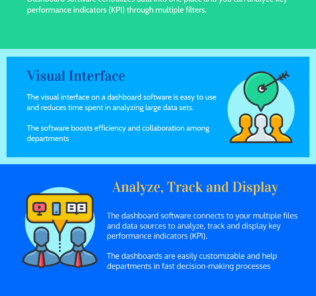
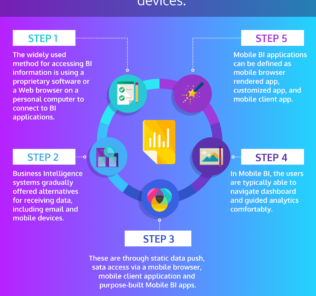

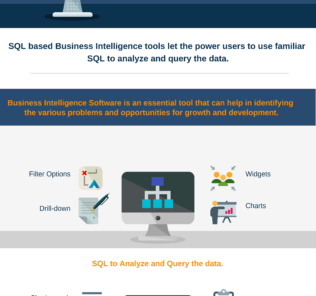
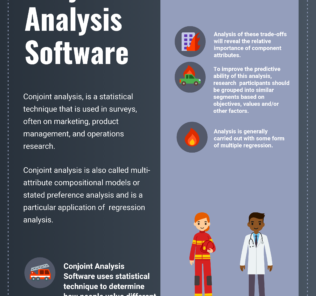
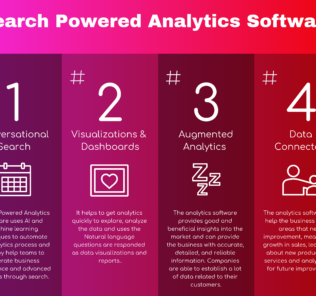




By clicking Sign In with Social Media, you agree to let PAT RESEARCH store, use and/or disclose your Social Media profile and email address in accordance with the PAT RESEARCH Privacy Policy and agree to the Terms of Use.